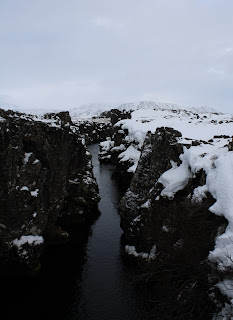Because the Lights were constantly moving, I wasn't able to get decent photos of them. However, take two parts the photos below, one part the swirling waves from "The Sorcerer's Apprentice" in Fantasia (if your memory is failing you, see from 3:45 onwards here) and you should have the right idea. If you really want to get authentic, mix in some uneasy horse whinnies and lie down in a pile of snow/ice for half an hour.
Since last we spoke (well, since I spoke; if this is a conversation I'm not being very equal with the discussion. That said, please do comment and discuss and revel in the new cultural pastime of blogmenting; Talk to me!) I've been to Reykjavik and back in one piece - although it was fairly touch and go at times - and we made a "class trip", so to speak, to Geysir, Gulfoss, and Þingvellir. I won't bore you with the details of Reykjavik, but the other three are worth a mention.
Þingvellir (pronounced "Thingvellir") was the site of the meeting of the Icelandic Parliament from 930 to 1789. All the laws were discussed and decided there, so it's a very important place for Iceland's history. It's also a hotbed of geothermal activity. It sits on the continental drift between the North American and Eurasian Plates, and it's literally ripping at the seams. Last week alone, they experienced something like 12 earthquakes there.
 |
| The craic was mighty in Þingvellir... |
Gulfoss is pretty self-explanatory when you see the pictures, but it's also pretty, hence the pictures.
Geysir is even self-explanatory without pictures, but here are some anyway. This geysir goes about every 7 minutes. The larger one has been dormant for the past few years. For a while they were able to prod it into activity by dumping loads of salt into it, but they gave that up after a while.
Along with reading A Hitchhiker's Guide to the Galaxy and attempting to knit myself a pair of mittens, the discussions and debates that naturally arise when nine liberal-minded engaged people are put under the same roof are proving an interesting way to while away the Icelandic evenings. Some of these conversations are less articulate than others; I have recollections of attempting to explain to Paulo how shareholders in a company work using cold, leftover chips as my medium after a decent amount of the cheapest wine we could find last week. However, sharing insights and resources is always going to be valuable. Thanks to Yvonne I've been watching Zeitgeist, which is a documentary that attempts to analyse the current malaise affecting humankind, addressing it from a cultural, religious, and financial standpoint. I haven't finished it yet so I can't speak for it as a whole; what I can say is that it's free (you can watch it on YouTube or on the site) and that it raises some very good points. I find its critique of corporate capitalism particularly interesting. It's 2 hours and 41 minutes long, so if you're looking for something engaging to watch of an evening, I'd recommend it. No indoctrination, no brainwashing. Just have an open mind and you never know what it might inspire.
~~~~~~
We're currently awaiting the potentially mind-blowing Northern Lights tonight, caused by the biggest solar flare in four years. The only thing that might rain on our parade is the clouds (Sorry, couldn't resist...); last night was supposed to be even more spectacular than Monday, but there was nary a flicker seen through the foggy blanket. We found our own spectacle, though - we went adventuring to an obscure natural hot pot, hidden away in the side of a mountain, nothing but a little snow-covered path off a dirt road (off a dirt road off a gravel road off a side road) and a No Camping sign to indicate its existence.
On a night like last night, I can see why the Icelanders are so superstitious about elves. There we were, sitting in volcanically heated water in what for all the world looked like a stone and peat-lined grave, surrounded on all sides by rolling hills bathed in eerie moonlight, the only sounds the trickling water and the howling wind. So I did the only thing an able-minded, logical person would do: I sprinted out of the hot pot, soaking wet in the frigid wind, and dove back into the little hut we had put our clothes in to get my camera and take some pictures. See if you can spot the elves.
The hardest part of hot-tubbing in Iceland is the entering and exiting. As you're changing into your swimsuit, listening to the wind outside, you do question your sanity. But once the barefoot speed-shuffle carries you to the water, you're grand. You relax, forget about the whole thing, and turn to mush. However, then comes the getting out bit. It took a good 10 minutes to steel ourselves for the task. When we all piled back into the little shed, we had to exercise our changing-in-the-dark-as-quickly-as-possible-before-hypothermia-onset talents (which I apparently do not possess, as I realised once we got home that the majority of my personal effects had been donned backwards and inside out.) Despite its perils, it is always worth it, especially in as magical a setting as we were fortunate enough to enjoy last night. Cheers, Mother Nature, you've done it again.
More photos here (also includes some pretty great Northern Lights shots from last week).




























